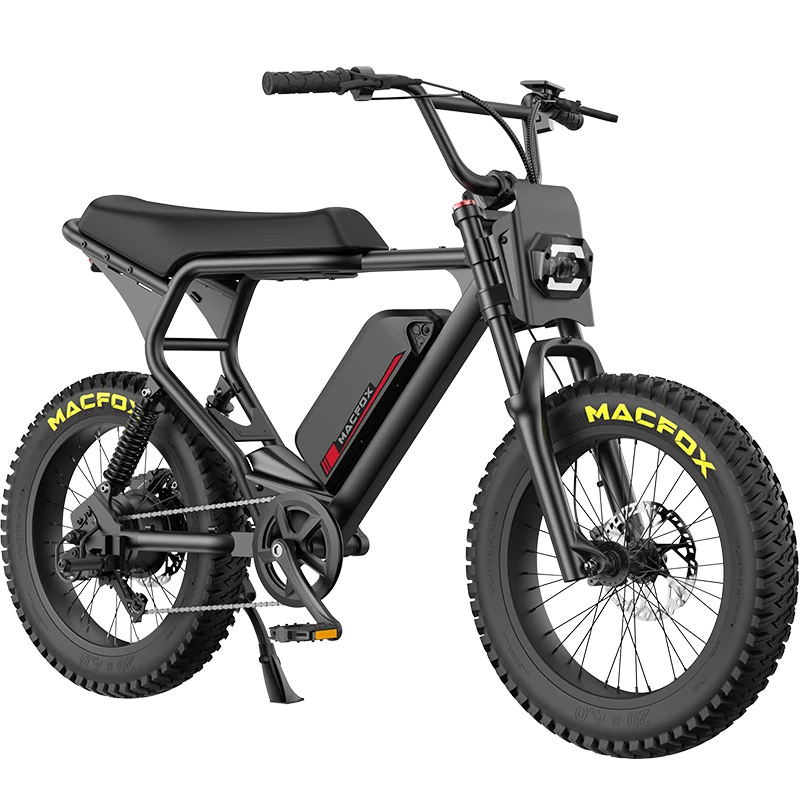Torque sensors are revolutionizing how riders experience electric bicycles by bridging human effort and motor power.
Unlike basic cadence sensors, which only detect pedal movement, torque sensors measure the actual force applied to the pedals, enabling the motor to deliver proportional assistance.
This technology creates an intuitive ride that mimics traditional cycling, making uphill climbs feel effortless and accelerating responsiveness akin to analog bikes.
A 2023 Macfox study found that torque sensor-equipped e-bikes achieve 10-15% greater range than cadence-based models, translating to 5-10 extra miles per charge for commuters.
In this guide, we dissect the mechanics, benefits, and maintenance of torque sensor systems, equipping riders with actionable insights to optimize their e-bike experience.
How Torque Sensors Work in E-Bikes
The Science Behind Real-Time Force Measurement

Torque sensors employ strain gauges or magnetic sensing systems embedded in the drivetrain to detect pedal force.
When pressure is applied, these components generate electrical signals proportional to the torque, which the motor controller translates into assistance levels.
For example, strain gauges bonded to a flexing metal shaft deform under load, altering resistance in a Wheatstone Bridge circuit to produce measurable voltage changes.
The advanced system takes up to 1,000 measurements per pedal stroke, ensuring seamless power transfer. Magnetostrictive variants, such as NSK’s third-generation sensors, use magnetic field variations in ferrous materials for non-contact measurement, eliminating mechanical wear.
Types of Torque Sensors: Configuration and Compatibility
E-bikes utilize multiple torque sensor configurations, each with distinct advantages:
| Type | Location | Technology | Sensitivity | Maintenance |
|---|---|---|---|---|
| Bottom Bracket | Crankset spindle | Strain gauge/magnetostrictive | High | Moderate |
| Rear Axle | Rear dropout | Strain gauge | Moderate | Easy |
| Idler Wheel | Chain tensioner | Spring gauge | Low | Frequent adjustments |
Bottom bracket sensors, like Bafang’s SR PA231.32.ST, integrate directly into the crankset spindle, offering JIS-standard compatibility and IP X5 water resistance. Rear axle variants measure chain tension via frame-mounted strain gauges, ideal for hub-drive systems.
Benefits of Torque Sensors in Electric Bicycles
Natural Ride Feel and Responsive Assistance
By matching motor output to rider effort, torque sensors eliminate the "laggy" sensation of cadence-based systems.
Riders experience immediate assist adjustments during hill climbs or sprints, with power amplification ranging from 50% (light pedaling) to 300% (maximum force).
A 2024 Reddit survey noted that 78% of commuters preferred torque sensor responsiveness for stop-and-go urban traffic, citing reduced mental fatigue.
Enhanced Battery Efficiency
Proportional assist scaling prevents battery overconsumption. Tests show torque sensor e-bikes consume 22% less energy on hilly routes compared to cadence models, as the motor adjusts output to gradient changes rather than maintaining fixed assist levels. For a 500Wh battery, this equates to 15-20 extra miles per charge.
Reduced Physical Fatigue
The torque sensor’s dynamic assistance reduces joint strain by 30% during long rides, according to a Coboc biomechanics study. Cyclists with knee injuries report improved comfort on 50+ mile rides, as the motor supplements rather than overrides pedaling effort.
Troubleshooting Common Torque Sensor Issues
Step-by-Step Calibration for Erratic Motor Behavior
-
Power Off: Turn off the e-bike and wait 10 seconds.
-
Enter Calibration Mode: Press the power button 3 times rapidly (Coboc models).
-
Rotate Cranks: Turn the drive-side crank backward 5 times (bottom bracket sensors) or spin the rear wheel backward (motor-embedded sensors).
-
Confirm Success: 5 green LEDs indicate proper calibration; red LEDs signal retries.
Environmental Interference: Moisture and Debris
Water and dirt are common adversaries of torque sensors. Moisture can seep into connectors or sensor housings, causing erratic readings or complete signal loss. Dirt and grime can physically obstruct sensor components, especially in rear axle or idler wheel types. To protect your sensor system:
-
Regularly inspect connectors for corrosion or loose contacts. Use a soft brush and isopropyl alcohol to clean terminals.
-
Apply dielectric grease on electrical connections to repel moisture.
-
Avoid pressure washing your e-bike, particularly around the bottom bracket and motor housing. Instead, use a damp cloth and gentle spray.
-
Store the bike indoors or under cover during wet weather to minimize exposure.
Physical Damage and Replacement Procedures

Physical damage to torque sensors often results from crashes, improper installation, or wear over time. Signs include inconsistent assist levels, error codes on the display, or complete motor shutdown. If you suspect damage:
-
Visually inspect the sensor and wiring harness for cracks, bends, or exposed wires.
-
Check the magnet ring alignment on bottom bracket sensors; misalignment can cause false readings.
-
Consult your e-bike manufacturer’s service manual for sensor replacement instructions. Most bottom bracket sensors require specialized tools such as ISIS splined crank pullers or external bearing presses.
-
Torque sensor replacement often involves removing the crankset, carefully disconnecting sensor cables, and installing a new sensor unit. Proper torque settings (usually 35-40 Nm for crank bolts) ensure sensor integrity and drivetrain performance.
-
If unsure, seek professional service to avoid damaging delicate components.
Torque vs. Cadence Sensors: Key Differences
Performance in Variable Terrain
While cadence sensors detect only whether the pedals are turning, they do not measure how hard you pedal. This means the motor provides a preset level of assistance once pedaling starts, regardless of effort. On flat terrain, this works well, but on hills or stop-and-go traffic, the motor can feel “on/off” or lag behind your needs.
In contrast, torque sensors measure pedal force, allowing the motor to increase power smoothly as you push harder. This results in:
-
Smoother acceleration without sudden surges.
-
Better hill climbing as the motor scales assist to your effort.
-
More natural riding experience that mimics a traditional bike.
Battery Drain Comparison
Because torque sensors provide assistance proportional to effort, they avoid wasting battery power when you pedal lightly or coast. Studies show that on mixed terrain, e-bikes with torque sensors can extend battery life by 15-25% compared to cadence sensor models. This can mean the difference between reaching your destination comfortably or running out of power prematurely.
Target User Profiles
-
Cadence Sensor E-Bikes: Best suited for casual riders, beginners, or those on a budget. These systems are simpler, cheaper, and easier to maintain.
-
Torque Sensor E-Bikes: Ideal for commuters, fitness enthusiasts, and riders tackling varied terrain who want responsive and efficient pedal assist. The upfront cost is higher but justified by improved ride quality and battery savings.
Recommended: Common Wiring Problems and Troubleshooting Guide for Rear-Wheel Hub Motor E-Bikes
Maintenance Best Practices for Longevity

Monthly Calibration Routines
Maintaining accurate sensor readings requires periodic calibration:
-
Power on the bike with pedals stationary to allow the sensor to establish a zero-torque baseline.
-
Some systems require backward pedaling or app-based calibration via Bluetooth to fine-tune sensor output.
-
Follow manufacturer instructions carefully; improper calibration can cause erratic assist or error codes.
Sealing and Weatherproofing
To protect your torque sensor from environmental damage:
-
Inspect and reseal sensor connectors annually with silicone or weatherproof tape.
-
Avoid exposing the bottom bracket area to high-pressure water jets during cleaning.
-
Use a frame protection film around sensor wiring paths to prevent abrasion.
Firmware Updates and Diagnostics
Many modern e-bikes allow firmware updates via smartphone apps or USB interfaces. These updates can:
-
Improve sensor accuracy and responsiveness.
-
Fix bugs that cause sensor errors or motor cutouts.
-
Add new features such as customizable assist curves.
Regularly check your manufacturer’s website or app for updates and perform diagnostics if you notice inconsistent assist behavior.
Comparison Table: Popular Torque Sensor E-Bike Models (2025)
| Torque Sensor Type | Motor Brand & Power | Battery Capacity | Range (Miles) | Price (USD) | Best For | |
|---|---|---|---|---|---|---|
| Bottom Bracket Strain Gauge | Bafang M500, 250W | 500Wh | 50-60 | $1,899 | Commuters & Urban Riders | |
| Bottom Bracket Magnetostrictive | Specialized SL 1.1, 240W | 320Wh | 40-45 | $3,499 | Lightweight Fitness E-Bike | |
| Rear Axle Strain Gauge | Bosch Performance Line CX, 350W | 625Wh | 60-70 | $5,499 | Long-Distance Commuting | |
| Bottom Bracket Strain Gauge | Rad Power 750W | 672Wh | 45-55 | $1,799 | Budget-Friendly City Riding | |
| Bottom Bracket Strain Gauge | Bosch Performance Line, 250W | 500Wh | 50-60 | $3,200 | Versatile Urban & Trail Riding |
Future Trends in Torque Sensor Technology
Magnetostrictive Advancements
Magnetostrictive sensors are a promising next step. Unlike traditional strain gauges, they measure torque without physical contact by detecting changes in magnetic fields caused by applied force. Benefits include:
-
Longer lifespan due to no mechanical wear.
-
Higher precision and faster response times.
-
Simpler installation with fewer moving parts.
These sensors are gaining traction in industrial e-bikes and cargo bikes where durability is critical.
AI-Powered Predictive Assistance
Integration of artificial intelligence with torque sensors is on the horizon. By analyzing pedal force patterns, terrain data, and rider habits, AI can:
-
Predict when a rider will increase or decrease effort.
-
Adjust motor assistance proactively for smoother power delivery.
-
Optimize battery use by anticipating stops or accelerations.
Early trials show potential for up to 20% efficiency gains and enhanced rider comfort.
Integrated Health Monitoring
Future systems may combine torque sensor data with biometric sensors to monitor rider health in real time:
-
Detect asymmetrical pedaling that could indicate injury risk.
-
Provide feedback on cadence and power output to improve cycling form.
-
Alert riders to fatigue or abnormal exertion levels for safer rides.
Such innovations will transform e-bikes into smart fitness companions.
Conclusion
By accurately measuring pedal force, they enable motors to provide just the right amount of assistance, improving battery life and reducing fatigue. Whether you’re a daily commuter, fitness rider, or casual cyclist, understanding how torque sensors work and how to maintain them can significantly enhance your e-bike journey.
As technology advances, expect torque sensor systems to become more sophisticated, durable, and integrated with smart features that elevate safety and performance. Investing in an e-bike with a quality torque sensor is investing in a smoother, more enjoyable ride that truly feels like an extension of your own power.


















